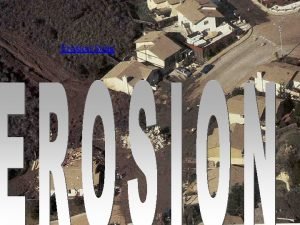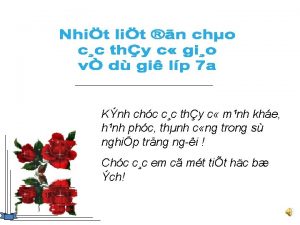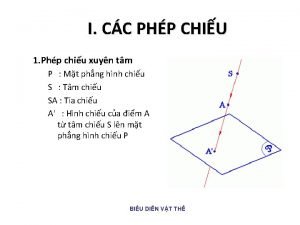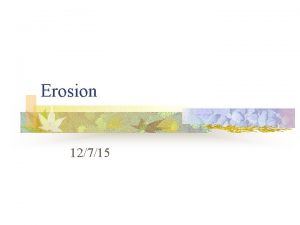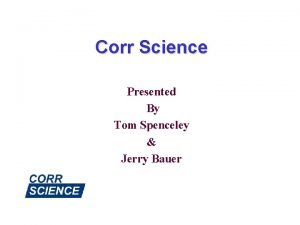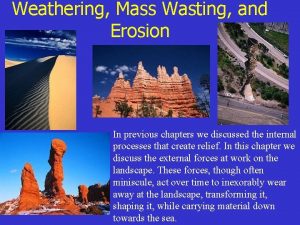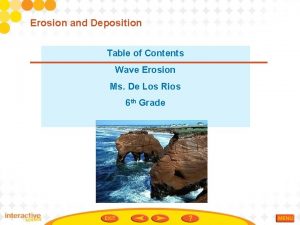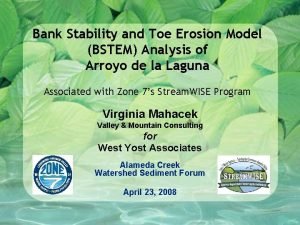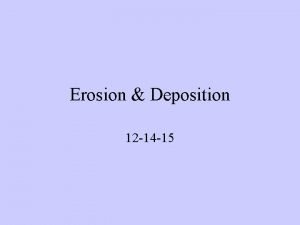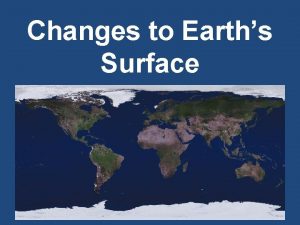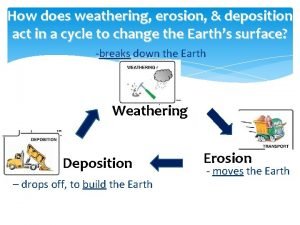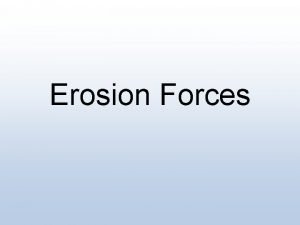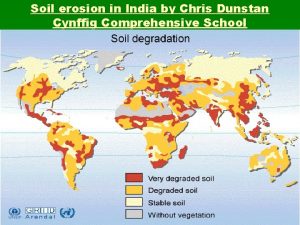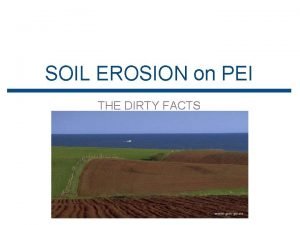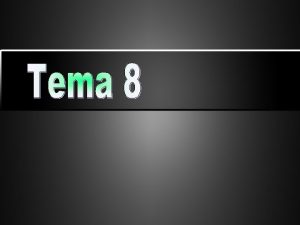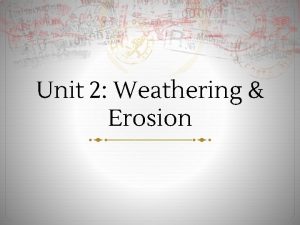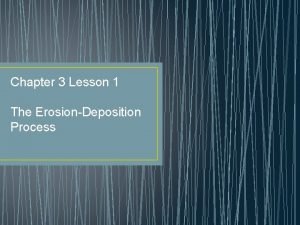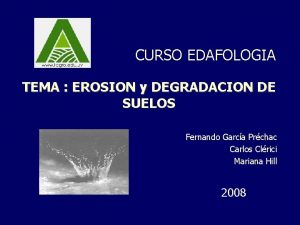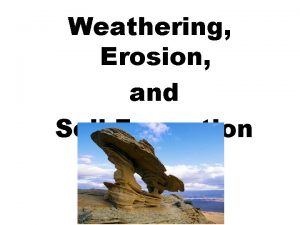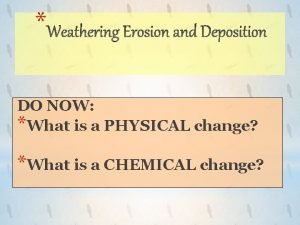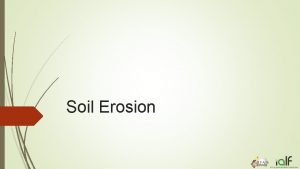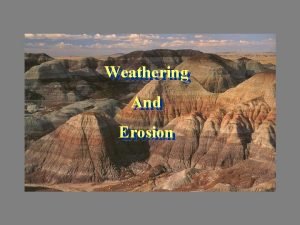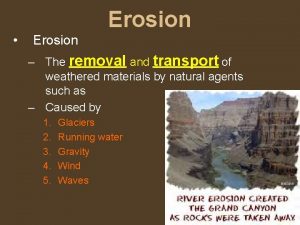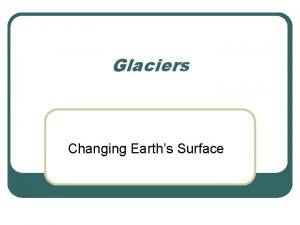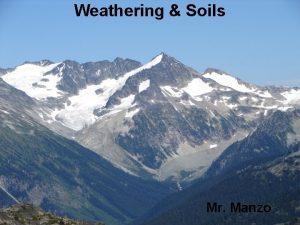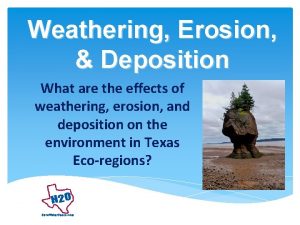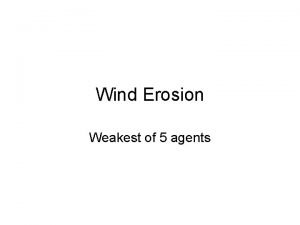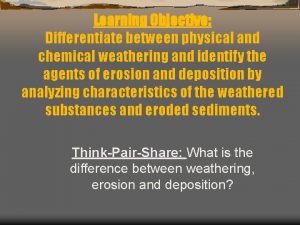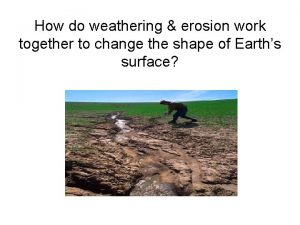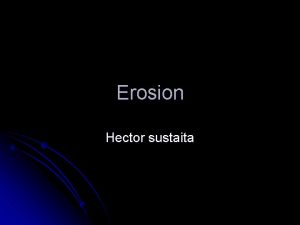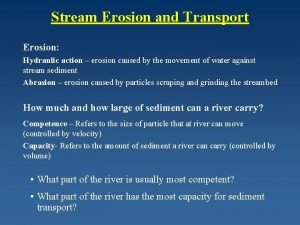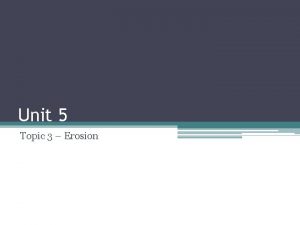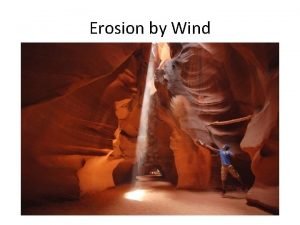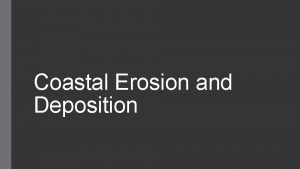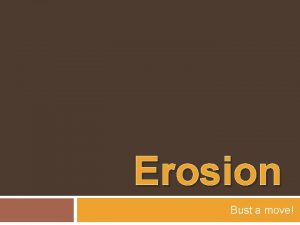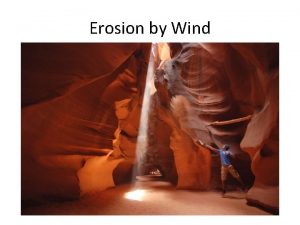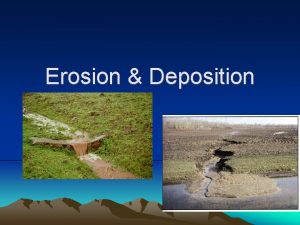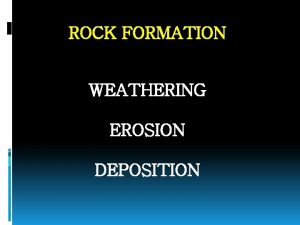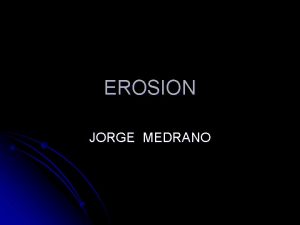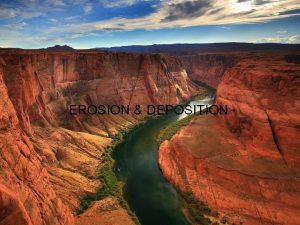Erosion Song EROSION Erosion is the transport of
























































































- Slides: 88

Erosion Song

EROSION: • Erosion is the transport of sediments around the earth • Erosion is driven by the force of gravity.


THE AGENTS OF EROSION ARE: 1. 2. 3. 4. RUNNING WATER MOVING ICE (GLACIERS) GRAVITY (Mass Movements) WIND

What is the The primary agent of erosion? RUNNING WATER

Colorado River


Grand Canyon

Niagara Falls




Agents Erosion Each agent of erosion produces its own characteristic shape and texture in the sediment.

Erosion by water makes The rock get ROUND and SMOOTH,

EROSION BY WATER: PARTICLES ARE CARRIED IN SEVERAL WAYS DEPENDING ON THEIR SIZE

How do streams transport sediment:

SEDIMENTS that can dissolve are transported IN SOLUTION: Examples: • Salt • Calcite

Dissolved ions in solution

Small SEDIMENTS are transported IN SUSPENSION Examples: • SILT • CLAY


: Large Sediments dragged along the bottom

What determines how large a sediment a stream can erode?

What does the velocity (speed) of the stream depend upon?

VELOCITY OF A STREAM DEPENDS ON: v. SLOPE (gradient) AND v. DISCHARGE (volume of water)

Where does a stream flow the fastest on straight path? (middle, sides, top or bottom) Top View Side of Stream (Stream Bank) Bottom of Stream • • The forces of friction, cohesion and drag all play a role in the streams velocity. Stream velocity is highest in the middle and top. Side of Stream (Stream Bank) Top of Stream

B Maximum erosion occurs where there is maximum velocity _______ C D On a straight path the maximum velocity center is in the ______ surface below the ______ E F

When rivers enter a large body of water their velocity decreases and deposition occurs (depositing of sediments) How are the sediments deposited? Nissequogue enters the Long Island Sound

SEDIMENTS LEFT BEHIND BY STREAMS ARE ____ SORTED dropped off in size order

SORTING

What is the relationship between particle size and water velocity? (SEE REF. TABLE PAGE 6)

Stream Velocity • The Relationship of Transported Sediments to Water Velocity: When velocity of the stream increases the size of the particle eroded increases

CALCULATE THE MINIMUM VELOCITY OF A STREAM NEEDED TO CARRY A PEBBLE (1 cm in size):

(SEE REF. TABLE PAGE 6)

What effect does erosion and deposition have on the stream? It causes the stream to go through stages THE MOVEMENT OF THE WATER CAN EVENTUALLY FORM AN OXBOW LAKE

Young Stream

Mature Stream Oxbow Lake

Old Age Stream

Comparing Young and Old Age Streams • • • Young Narrow V – shaped valley Straight path Steep slopes Fast moving water Waterfalls, rapids • • Mature/Old Age Wide valley Many meanders Low slope Oxbow Lakes

Young Streams create V shape valleys

Old Stream

Why does a stream develop meanders?

Water moves faster on the outside of a bend DEPOSITION (EROSION) Water moves slower on the inside of a bend (DEPOSITION) EROSION

A B C D E

A B C D E

A B C D E

A B C D E

A B C D E

A B C D E

A B C D E

A B C D E

A B C D E

A B C D E

A B C D E

WHY DID RUBBER DUCKY “C” WIN THE RACE? A B C D E

WHY WOULD THE WATER MOVE FASTER IN THE MIDDLE AND SLOWER NEAR THE SIDES? A B C D E


WHICH RUBBER DUCKY IS GOING TO WIN? A B C D E START FINISH

A B C D E START FINISH

A B C D E START FINISH

A B C D E START FINISH

START E D A C B FINISH

START E D C A B FINISH

START E D C A B FINISH

START E D C A FINISH B

WHY DID RUBBER DUCKY “B” WIN THE RACE? START E D C FINISH A B

WHAT WOULD A CROSS SECTION (SIDE-VIEW) OF THE STREAM LOOK LIKE AT THE FINISH LINE? AERIAL VIEW (A) (B) (C) CROSS-SECTION (SIDE VIEW) (D)

What factors affect deposition rate in a river? Characteristics of the sediment animation • • • Size Shape Density

RATES OF DEPOSITION DEPEND ON: • 1. Particle size: ____ • particles (clay, silt) settle more slowly than larger particles.

2. Particle shape: • ______ between water and the surface of particles _______ settling. • As the surface area ______ the time it takes to settle _____ • The rounder the particle the faster ______ it will deposit.

3. Particle Density: • ______ particles settle faster. •

What is the relationship between settling rate and particle size? Complete the graphs: label each axis Settling rate Particle size Increase

What is the relationship between settling rate and shape? Settling rate Particle gets flatter

What is the relationship between settling rate and density? Settling rate Density increases

What is the relationship between Settling Rate and Settling Time? • As the settling time increases The settling rate Inverse Relationship Settling time

Describe the size, shape and density of a particle that deposits quickly (greatest rate) • A particle that is large, round and dense.

How does the velocity of the transporting medium ( water, wind, ice) affect deposition? • The slower the velocity of the • water the ____ • particles will settle. • It takes longer for particles to settle • in ______ water.

What is horizontal sorting and when does it occur? • animation

• • Horizontal Sorting: a gradual change in the size, shape and density (of deposited particles) when a stream enters a large body of water and slows down.

boulders Horizontal Sorting cobbles Roundest and densest pebbles sand silt Smallest flattest least dense (colloids) clay Precipitation ……………. Ions in ……………. solution

Draw this diagram of horizontal sorting.

What is a delta and how does it form? • A delta is forming where the Nissequogue River meets the Longs Island Sound.

Mississippi River Delta

Nile River Delta

• Delta is a triangle shape feature that forms at the mouth of the river where sediment is deposited

What is vertical sorting? • Animation

Vertical Sorting of particles from bottom to top in a layer. Occurs during flood events or when a landslide falls into a body of water Small Flat Low density Large Round Dense

What is graded bedding and when does it occur? animation • Series of vertical sorting happen over and over again. • Occurs when Landslides happen over and over again. Also when flooding occurs

Graded Bedding: Each layer represents a single event of deposition (3 floods)
 Sự nuôi và dạy con của hươu
Sự nuôi và dạy con của hươu Khi nào hổ con có thể sống độc lập
Khi nào hổ con có thể sống độc lập Soil erosion control measures
Soil erosion control measures Selectively permeable definition biology
Selectively permeable definition biology Primary active transport and secondary active transport
Primary active transport and secondary active transport Primary active transport vs secondary active transport
Primary active transport vs secondary active transport Now answer the following questions
Now answer the following questions Bioflix activity membrane transport active transport
Bioflix activity membrane transport active transport Passive transport vs active transport venn diagram
Passive transport vs active transport venn diagram Active transport and passive transport
Active transport and passive transport Sodium potasium pump
Sodium potasium pump Unlike passive transport, active transport requires
Unlike passive transport, active transport requires Erosion song
Erosion song Cách chứng minh hai đường thẳng song song
Cách chứng minh hai đường thẳng song song đoạn mạch mắc song song
đoạn mạch mắc song song What makes a song a song
What makes a song a song động vật sống dưới nước
động vật sống dưới nước Phép chiếu song song
Phép chiếu song song Sing to the king
Sing to the king Giọng song song là gì?
Giọng song song là gì? Tỉ lệ cơ thể trẻ em
Tỉ lệ cơ thể trẻ em Lời thề hippocrates
Lời thề hippocrates Vẽ hình chiếu đứng bằng cạnh của vật thể
Vẽ hình chiếu đứng bằng cạnh của vật thể đại từ thay thế
đại từ thay thế Quá trình desamine hóa có thể tạo ra
Quá trình desamine hóa có thể tạo ra Môn thể thao bắt đầu bằng chữ f
Môn thể thao bắt đầu bằng chữ f Công thức tính độ biến thiên đông lượng
Công thức tính độ biến thiên đông lượng Hát kết hợp bộ gõ cơ thể
Hát kết hợp bộ gõ cơ thể Từ ngữ thể hiện lòng nhân hậu
Từ ngữ thể hiện lòng nhân hậu Dot
Dot Thế nào là sự mỏi cơ
Thế nào là sự mỏi cơ độ dài liên kết
độ dài liên kết Chó sói
Chó sói Thiếu nhi thế giới liên hoan
Thiếu nhi thế giới liên hoan điện thế nghỉ
điện thế nghỉ Một số thể thơ truyền thống
Một số thể thơ truyền thống Thế nào là hệ số cao nhất
Thế nào là hệ số cao nhất Trời xanh đây là của chúng ta thể thơ
Trời xanh đây là của chúng ta thể thơ Frameset trong html5
Frameset trong html5 Thế nào là mạng điện lắp đặt kiểu nổi
Thế nào là mạng điện lắp đặt kiểu nổi Các số nguyên tố
Các số nguyên tố đặc điểm cơ thể của người tối cổ
đặc điểm cơ thể của người tối cổ Tia chieu sa te
Tia chieu sa te Các châu lục và đại dương trên thế giới
Các châu lục và đại dương trên thế giới Tư thế worms-breton
Tư thế worms-breton ưu thế lai là gì
ưu thế lai là gì Tư thế ngồi viết
Tư thế ngồi viết Cái miệng xinh xinh thế chỉ nói điều hay thôi
Cái miệng xinh xinh thế chỉ nói điều hay thôi Các châu lục và đại dương trên thế giới
Các châu lục và đại dương trên thế giới Mật thư anh em như thể tay chân
Mật thư anh em như thể tay chân Bổ thể
Bổ thể Tư thế ngồi viết
Tư thế ngồi viết Thế nào là giọng cùng tên?
Thế nào là giọng cùng tên? Thẻ vin
Thẻ vin Thơ thất ngôn tứ tuyệt đường luật
Thơ thất ngôn tứ tuyệt đường luật Bài hát chúa yêu trần thế alleluia
Bài hát chúa yêu trần thế alleluia Hệ hô hấp
Hệ hô hấp Diễn thế sinh thái là
Diễn thế sinh thái là Vẽ hình chiếu vuông góc của vật thể sau
Vẽ hình chiếu vuông góc của vật thể sau 101012 bằng
101012 bằng Sand dunes definition
Sand dunes definition Jerry corr
Jerry corr Weathering and erosion virtual field trip
Weathering and erosion virtual field trip Mass wasting
Mass wasting Table
Table Bank stability and toe erosion model
Bank stability and toe erosion model What property did meherjan lose due to river erosion
What property did meherjan lose due to river erosion Diagram of erosion and deposition
Diagram of erosion and deposition What are two examples of destructive forces
What are two examples of destructive forces Types of weathering
Types of weathering Erosion
Erosion Soil erosion in india
Soil erosion in india Factors affecting soil erosion
Factors affecting soil erosion Meteorizacion biologica
Meteorizacion biologica Weathering and erosion difference youtube video
Weathering and erosion difference youtube video The laying down or settling of eroded material
The laying down or settling of eroded material Suela de labor
Suela de labor Kinds of weathering
Kinds of weathering Is erosion a physical change
Is erosion a physical change Soil erosion def
Soil erosion def Agents of erosion
Agents of erosion Removal and transport of weathered materials
Removal and transport of weathered materials 5 agents of erosion
5 agents of erosion Erosion and weathering
Erosion and weathering Mechanical and chemical weathering venn diagram
Mechanical and chemical weathering venn diagram 5 agents of erosion
5 agents of erosion Water erosion
Water erosion Type of erosion
Type of erosion Dust bowl 1930s
Dust bowl 1930s












